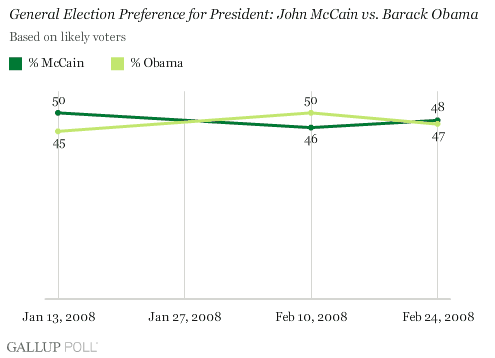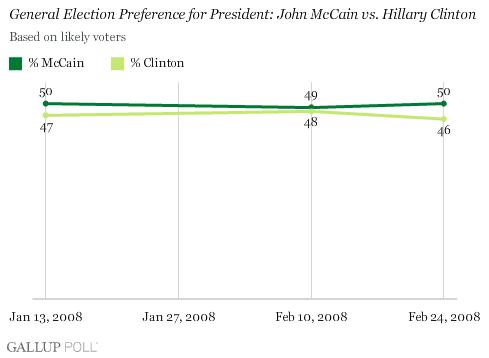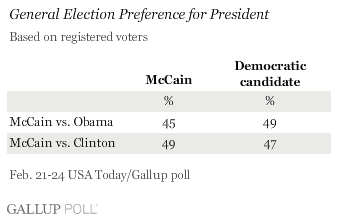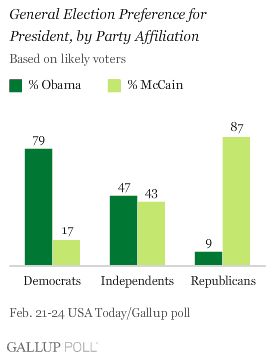PRINCETON, NJ -- Democratic front-runner Barack Obama and likely Republican nominee John McCain are essentially tied in likely voters' preferences for president if the general election were held today.

Forty-eight percent of likely voters say they prefer McCain for president, and 47% Obama, according to a new USA Today/���۴�ýpoll, conducted Feb. 21-24. The two have been closely matched each of the three times the question has been asked of likely voters this year.
The contest would be about as tight if Hillary Clinton were the Democratic nominee. In that test ballot, 50% of likely voters choose McCain and 46% Clinton.

The Democratic candidates do slightly better among all registered voters, but the two hypothetical races are still a statistical tie among this larger group of voters.

These close contests come in a political environment that is currently quite favorable to the Democratic Party: Democrats have a significant edge in terms of current party identification; the Democratic Party has much higher favorable ratings than the Republican Party; and when various polling organizations ask the "generic ballot," Americans decisively say that in theory they would prefer a Democrat to a Republican in office. (For more, see "Democrats Have Significant Identification, Image Advantage" and "Democrats' Hold on House Looks Secure, for Now" in Related Items.)
Thus, it appears McCain is doing better than what might be expected of the Republican nominee in general. One reason for this is that McCain is able to attract support beyond just Republican Party loyalists. McCain currently attracts more support among likely voters who identify as Democrats than either Democratic candidate attracts among Republicans who are likely to vote. Also, McCain is competitive with Obama among politically independent likely voters and leads Clinton by 10 percentage points among this group.


Implications
���۴�ýpolling on the general presidential election thus far has suggested the contest may be quite close, and the outcome could be similar to what occurred in the prior two presidential elections. This is in spite of the fact that everything else being equal, the Democratic candidate this year should be leading the Republican candidate. As these data show, McCain is able to transcend party to some degree, because he has more crossover appeal than either Democrat. Also, the general election campaign is just getting started. Over the next eight months, Democrats will attempt to link McCain to an unpopular incumbent president, and to hold the Republican Party responsible for a faltering economy and general discontent with the way things are going in the country. If they are successful in doing so -- assuming Americans' attitudes do not improve considerably between now and November -- then the Democratic candidates may run stronger in future general election trial heats. At the same time, of course, Republicans will be attacking the Democratic nominee -- all to suggest that a lot can change between now and next Nov. 4.
Survey Methods
Results are based on telephone interviews with 1,653 likely voters, aged 18 and older, conducted Feb. 21-24, 2008. For results based on the total sample of national adults, one can say with 95% confidence that the maximum margin of sampling error is ±3 percentage points.
Interviews are conducted with respondents on land-line telephones (for respondents with a land-line telephone) and cellular phones (for respondents who are cell-phone only).
In addition to sampling error, question wording and practical difficulties in conducting surveys can introduce error or bias into the findings of public opinion polls.
